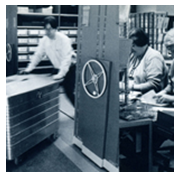Bankgirot was established in 1959 by the Swedish banks. At that time the name was Bankgirocentralen, shortened as BGC. Bankgirot’s task was to develop and maintain a system of payment that was completely open, that minimised costs, provided economy of scale advantages and had a high level of security. Since then, Bankgirot has developed and changed. You can read about the major events in Bankgirot’s history here.
2023
Bankgirot gets the assignment to create solutions for future payment infrastructure in Sweden, when P27 withdraws their clearing license application in the spring.
Bankgirot is named Sweden's second most healthy workplace, after being the best in the financial sector for several years.
2022
The payment system Payments in Real Time (BiR), which enable Swish, celebrate ten years.
Bankgirot follows the tense situation in the world after Russia's invasion of Ukraine, and deepens the dialogue with authorities and other actors in the financial sector.
Bankgirot introduces hybrid working methods when employees get the opportunity to start working in the office after the pandemic.
2021
In December, for the first time, 200 million payments are handled in Bankgirot's system during one month. The value of the transactions amounts to almost SEK 2000 billion.
A new record is made in the Payments in Real Time system in November, when 3,6 million Swish payments are handled during one month.
Gert Andersson is appointed CEO of Bankgirot in August.
The EU Commission approves P27's acquisition of Bankgirot, which now becomes a subsidiary of P27.
2020
Bankgirot’s mission is to ensure stability in existing infrastructure, and prepare for a responsible termination of services.
The owners of Bankgirot and P27 signs an agreement of acquisition, making P27 the owner of Bankgirot. The acquisition needs to be approved by both Swedish and European authorities.
85 percent of Bankgirot’s employees begin to work remotely, when Split Operations is introduced in March to reduce the risk of spreading the coronavirus.
600 servers and 300 databases are moved to Bankgirot’s operating supplier. The outsourcing that was started in 2019, is now completed.
2019
The system Payments in Real Time celebrates a billion payments since its inception in 2012.
Bankgirot turns 60 years, and celebrates its role as enabler in the payment market together with clients, employees and partners.
2018
Decision on outsourcing of IT operation, and extended outsourcing of development to partners.
2017
Jeanette Jäger is appointed CEO of Bankgirot.
In May, Bankgirot moves to new premises in Liljeholmen.
2016
Swish wins the inUse Award - a design prize that focuses on presenting good examples of usability and overall experience rather than just appearance.
Swish for Commerce is launched in January. There are now three solutions for payments in real time: Swish Private (payments between persons), Swish Business (payments from a person to a company, association or organization) and Swish for Commerce (for m- and e-commerce transactions).
2015
In the end of 2015 Swish, which Bankgirot manage and develops on behalf of Getswish AB reached 4 million active users. The verb to swish (swisha in Swedish) was included in the 2015 list of new Swedish words issued by the Language Council of Sweden.
Torbjörn Ericsson is CEO.
2014
Bankgirot was awarded with the Model Bank Award for the development of Payments in Real Time by the analyst firm Celent.
On 29 December Bankgirot settled interbank payments totalling more than SEK 116 billion.
2013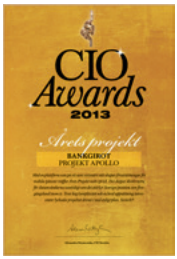
As one of the first clearing houses to do so Bankgirot conducted an internal self-assessment in accordance with the Principles for Financial Market Infrastructures (PFMI).
Bankgirot's Payments in Real Time and Swish have gained a great deal of international attention and have been generously rewarded i.e. the project Apollo's development of Payments in Real Time and Swish was named Project of the Year by CIO Sweden at the CIO Awards.
2012
Bankgirot launched a new payment system, Payments in Real Time (Betalningar i realtid). The first payment flow to be connected to the new platform is the mobile payment solution, Swish, which was launched in December by six Swedish banks.
On 24th April, BGC changed its name to Bankgirot and a new brand was implemented in October. In 2012, Bankgirot employed some 240 staff.
2011
Bankgirot took over the product ownership for e-invoicing (E-faktura) after previously having been responsible for operation, development and customer service. A new version of Autogiro, where all information is electronic, was launched in November. In total, 791 million payments were processed.
On 28th February 2011, the bank giro system dealt with 42 million transactions in a day, breaking the previous record of 35 million in 2009.
2010
Parts of the bank giro system, Autogirot’s consent handling and issuer disbursements (emmitentutbetalningar), were set into production on the English VocaLinks platform in February. Continued development of the new infrastructural solutions within electronic identification and e-invoice. Finansinspektionen (Financial Supervisory Authority) issued a permit for the new identification service, eID Gateway.
2009
The number of employees is 220, 770 million transactions carried out and SEK 9356 billion handled. 90 percent of all payments are dealt with electronically. Preparations for transferring operation and maintenance of the bank giro platform to VocaLink are ongoing. Bankgirot celebrates 50 years in business.
2008
Development and maintenance outsourced to Logica. Birgitta Simonsson is MD.
2007
Employees: 340 in no., number of transactions: 620 million in no., amount handled: SEK 6 686 billion. 87 percent of all payments now handled electronically. Bankgirot initiates strategic cooperation with the English, VocaLink.
2006
Bankgirot launches Bankgiro Receivables (Bankgiro Inbetalningar) as a comprehensive and more efficient receivable payment service.
2004
Eva Gidlöf is MD.
2003
Electronic ID service launched which is used in e.g. self-assessment returns.
2002
Preparations for possible EMU affiliation. Number of transactions: 363 million, of which 78 percent are electronic, handled amount was SEK 4 043 billion.
1999-2000
Bankgirot’s parent banks plan to buy Postgirot and merge Postgirot with Bankgirot into Svenska Girot. The plans halted by the competition authority. This led to many banks deciding to rely on Bankgirot instead of having two giro solutions.
New clearing and settlement system. Settlement takes place on the handling day which makes the payment system faster. A solution for e-invoicing launched. Privatgirot takes over all paper handling (paper-based payments).
1998
Development work for preparing the payment system. Bankgirot introduces new requirements for clearing and settlement, the new millennium as well as the new Euro currency. Ragnar Santesson is MD.
1996-1997
Alternative forms of payment introduced e.g. via internet. 1997: Employees: 669 in no., number of transactions: 290 million, amount handled: SEK 2 623 billion.
1995-1996
Foreign banks open branches in Sweden, contributing towards more banks connecting up to the bank giro system. Decision taken regarding new production platform improving the efficiency of Bankgirot’s activity. The Internet offers new opportunities.
1994
New agreement structure in relation to bank customers created whereby the bank conducts the entire business with the bank customer. Deregulation of state payments; previously, all state payments had to be sent through Postgirot. New Swedish banks established. Opportunity introduced for tax refunds to be deposited on bank account.
1992
New Autogiro starts with new and improved functionalities. New data gathering technology, IMAGE, introduced. Manual registration of slips disappears. Employees: 750 in no.
1989
Businesses have an opportunity to send in payment assignments to Bankgirot directly (Bg-Direkt). Sven Schelin is MD.
1988
Bankgirot builds new premises and moves into the Globen area. IBM installed as a supplement to Unisys. Employees: 1131 in no., number of transactions: 179 million, amount handled: SEK 1 533 billion. Privatgirot establishes its own joint stock company.
1987
Bankgirocentralen becomes Aktiebolag Bankgirocentralen BGC AB. Automatic mailing of deposit information commences.
1986
Foreign banks have an opportunity to establish themselves in Sweden via subsidiaries, contributing to more foreign banks connecting up to the bank giro system.
1985
New communication program for PC customers, "Telebankgiro". Registration of account card notes grows considerably.
1984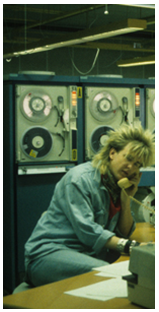
Bankgirot takes over Bankomatdriften, the data system for bank ATMs. Bankgirot sends out supplementary information about ATM withdrawals between different banks.
1982
New supplier payment (Leverantörsbetalning) routine with new functions adapted to small and large businesses.
1981-1984
Change of mainframe computers from ICL to Unisys, contributing to increased standardisation of bank systems.
1981
Bankgirot handles the bank’s assignments in respect of private individuals and businesses. A new payment routine now developed for private individuals. Private individuals sent payment slips in envelopes to Bankgirot which, in turn, registered the payments and sent the information to the payee.
1980
Tax payments via Bankgirot offered to businesses with monitoring of due-by dates. Employees: 758 in no., number of transactions: 91 million, amount handled: SEK 486 billion.
1979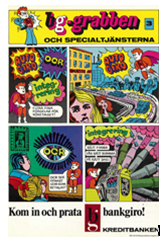
A few years earlier, the minister of finance had appointed a committee regarding the relationship between Postgirot and Bankgirot. The question is raised as to whether it was rational for Sweden to have two competing giro systems. A report submitted in 1979 determined, however, that competition ”affords major advantages”.
1975
Teletransmission, information sent via tele-network, to and from Bankgirot.
1974
Ingvar Anderberg is MD at BGC. Responsibility for the banks’ data clearing now lies with Bankgirot.
1970
OCR technology established together with the electronic reading-off of payment slips. Creates integration with the recipients’ accounts receivable. Employees: 400 in no., number of transactions: 31 million, amount handled: SEK 99 billion.
1969
Autogiro for payments from private individuals starts at BGC. Account deposit routines for salaries, pensions, etc.
1967
Autogiro for businesses introduced at BGC. First recipient is ICA-Eol in Gothenburg.
1966
Automatic routine for Supplier Payments (Leverantörsbetalningar) commences at BGC. The first customers are Volvo and the County of Stockholm County Council. Bankband to the banks; communication via data technology starts now.
1965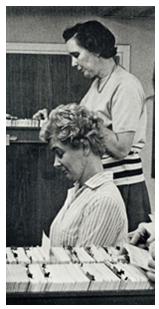
The first computers are installed at Bankgirot; the so-called MICR technology is introduced. Slips are registered and, at the same time, the means of readability of these by computer is created.
1964
Lennart Börnfors is MD at BGC.
1960
About 100 employees and around a million transactions carried out. The routines are completely manual. Sparbankernas Bank and Jordbrukets Bank join up, which means that all Sweden’s business banks, agricultural finance institutions and savings banks are now part of the bank giro cooperation.
1959
Bankgirocentralen (BGC) starts up (consortium) on 16th November at Lilla Nygatan 23, which was Stockholm Enskilda Bank’s first head office. The banks who signed the agreement on Bankgirot were - Bohusbanken, Jämtlands folkbank, Skaraborgs Enskilda Bank, Smålands Bank, Sundsvalls Enskilda Bank, Sveriges Kreditbank, Wermlands Enskilda Bank, Göteborgs Bank, Skandinaviska Banken, Skånska Banken, Stockholms Enskilda Bank, Svenska Handelsbanken, Uplands Enskilda Bank and Östergötlands Enskilda Bank. Curt G Ohlsson is MD at BGC.
1950-1959
Tests with paper-based payments between the individual bank branches conducted.


